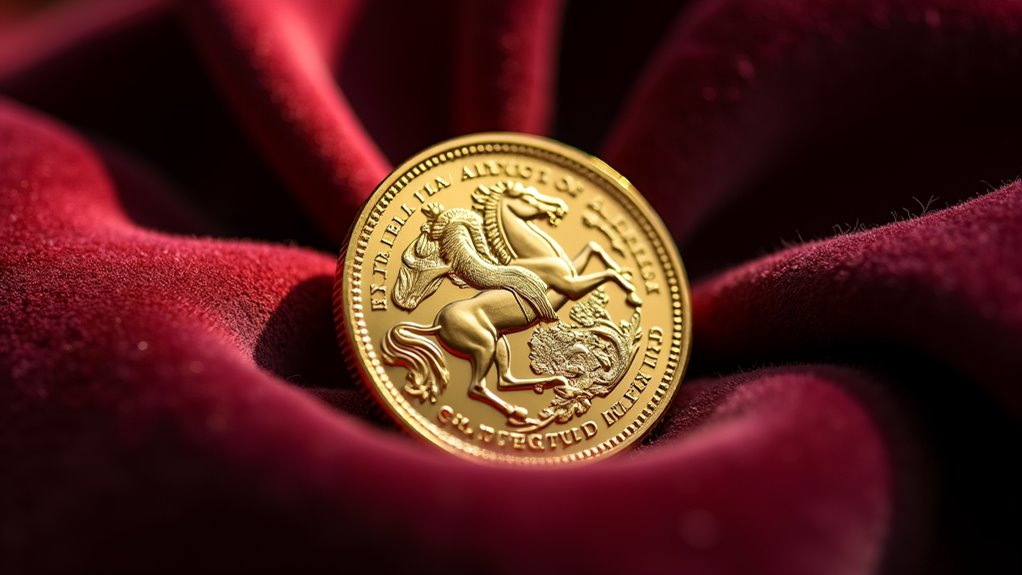Professional coin grading through NGC and PCGS follows the Sheldon Scale, ranging from 1 to 70, with 70 representing a perfect specimen. Expert graders meticulously examine coins under magnification, evaluating wear patterns, lustre, and surface imperfections. Both services employ multiple graders for consistency, though PCGS maintains slightly stricter standards. The tamper-proof encapsulation process authenticates and protects coins while providing detailed certification. Understanding these nuances reveals the true potential of your gold coin’s value.

When it comes to determining the true value of gold coins, professional grading serves as the foundation of numismatic assessment and market worth. The two leading authorities in coin grading, NGC and PCGS, employ a meticulous process that transforms raw coins into certified collectables through authentication, grading, and encapsulation. This process is crucial for ensuring that collectors can trust the historical significance of each piece.
The grading process follows the Sheldon Scale, a numeric system ranging from 1 to 70, where 70 represents a flawless specimen under 5x magnification. Expert graders examine essential factors including wear patterns, lustre quality, strike characteristics, and surface imperfections. Both NGC and PCGS utilise multiple graders to guarantee consistency and accuracy in their assessments, though PCGS is generally recognised for implementing slightly more stringent standards. This meticulous evaluation ensures that only the highest quality coins are awarded top grades.
Professional grading greatly impacts a coin’s market value and collector appeal. A single grade difference, such as between MS64 and MS65, can double a coin’s worth. The encapsulation process protects these valuable assets in tamper-evident holders, preserving their condition and preventing environmental damage. This standardised approach to quality assessment has revolutionised the global coin trading market, providing collectors and investors with reliable authentication and condition verification. Additionally, the allure of ancient gold coins further enhances the significance of grading, as collectors seek to acquire historically important pieces. The premiums associated with certified gold often stem from its verified purity, which is a crucial factor in investor trust.
Professional grading transforms raw coins into prized collectibles, where a single grade improvement can dramatically multiply market value and investment potential.
While both NGC and PCGS dominate the market, they maintain distinct characteristics. NGC offers extensive population reports and flexible policies regarding crossover and re-grading options. PCGS, which pioneered encapsulated third-party grading in 1986, often commands premium prices due to its reputation for strict grading criteria. Both services stand well above second-tier grading companies like ANACS and ICG.
The grading process specifically benefits gold coins by establishing credibility and preventing counterfeiting. Mint State (MS) coins, graded from MS60 to MS70, indicate pieces that have never circulated, while Proof (PR) designations apply to specially-struck collector editions. The highest grades, particularly MS70 or PR70, represent exceptional specimens that often attract considerable premiums in the marketplace. Additionally, the importance of gold hallmarking ensures that collectors can trust the purity of their investments, further enhancing the value of graded coins.
Authentication through these respected services verifies not only a coin’s physical condition but also its historical relevance and legitimacy. The tamper-proof holders include detailed certification information, creating an unbreakable chain of authenticity that proves invaluable during auctions or private sales. This standardisation has helped establish a more transparent and reliable market for numismatic trading globally.
The encapsulation process serves as the final step, sealing coins in specialised holders designed to showcase the pieces while protecting them from handling damage and environmental factors. These holders feature clear viewing panels and permanent grade assignments, guaranteeing that the coin’s condition remains stable and its certification remains uncompromised throughout its collecting lifetime.
Frequently Asked Questions
How Much Does Professional Coin Grading Typically Cost per Coin?
Professional coin grading costs typically range from $22 to $300+ per coin, depending on several factors.
Standard grading through PCGS starts at $22, while NGC’s basic service begins at $40. Higher-value coins or expedited services can reach $150-350.
Additional costs may include yearly membership fees (from $25), shipping, handling and insurance (around $50+).
Bulk submissions often qualify for discounted rates, making grading more economical per piece.
Can I Submit Coins Directly, or Must I Work Through Authorized Dealers?
Both direct submission and authorised dealer options are available, though requirements differ.
For direct submissions, collectors must hold memberships with grading services like NGC or PCGS, which involve annual fees ranging from $25-$149.
Without membership, submissions must go through authorised dealers who provide expertise and bulk submission benefits, albeit with additional handling fees.
The choice depends on one’s experience level and submission frequency.
What Happens if I Disagree With the Grade Assigned to My Coin?
If a collector disagrees with their coin’s assigned grade, both NGC and PCGS offer regrade or reconsideration services for an additional fee.
However, there’s no guarantee the grade will change. The coin may receive the same grade, a higher grade, or even a lower grade upon review.
Many collectors opt to accept the initial grade, as regrades often confirm the original assessment.
It’s worth noting that grading is inherently subjective, despite standardised criteria.
How Long Does the Entire Grading Process Usually Take?
The standard grading process typically takes 4-8 weeks from submission to return, including shipping times.
For economy submissions, NGC requires about 20 business days while PCGS takes 30-60 business days.
Expedited services can considerably reduce these timeframes to 1-3 weeks total.
Factors like seasonal demand, coin complexity, and service level chosen affect processing duration.
Large bulk submissions may extend beyond 5 months in some cases.
Are There Special Handling Requirements When Submitting Valuable Gold Coins?
Valuable gold coins require meticulous handling procedures to preserve their condition.
Collectors should always use cotton gloves when handling coins and hold them by their edges. Non-PVC protective flips are essential to prevent chemical reactions.
High-purity gold pieces need extra care due to their softness. Proper packaging with rigid materials and adequate padding is vital for safe transport.
Documentation detailing the coin’s history and proper insurance coverage should accompany all submissions.














